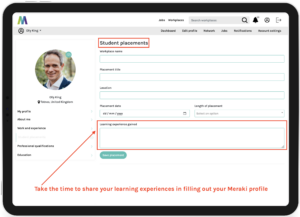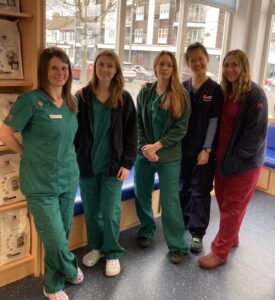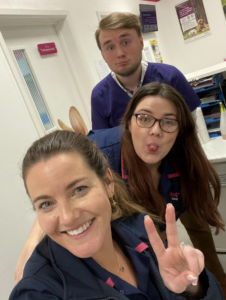by Olly King, Founder
Meraki HQ, Totnes, UK
Created 833 days ago
Clinical Extra-Mural Studies Top Tips: Part 2 - Things to do During Your Veterinary Placement
In Part 1 we covered the logistics of sourcing and arranging your placements. Having done the leg work to get there and built an initial rapport, we now cover how to behave and engage while on placement to ensure the best learning experience. Relentlessly invest the time on placement to nurture positive relationships with the whole team, and opportunities to get the hands-on you desire will come your way.
1. Relax, be yourself and have fun
Show up with a professional, positive, enthusiastic attitude and a willingness to get stuck in.
As a student, you are not expected to know everything, so have compassion for yourself if you cannot remember the hatch time of a fertile bearded dragon egg! But you are there to learn and to show an interest.
Adopt a personable, kind and respectful manner towards all team members and show gratitude for the experiences you get. Providing a high-quality C-EMS experience requires time and effort on behalf of the practice, ultimately costing the practice money in negatively impacting how much work they can get done.
Yes, you are going on placement with a long list of objectives. But remember you are entering a dynamic, business work environment. The pressures of providing efficient and quality veterinary care may get in the way and not always align with your priorities. So embrace a humble attitude with flexibility in your expectations so that each learning experience will feel like a win!
2. Be on time
Make a positive first impression and don’t be late, especially on day 1. Ensure you are dressed appropriately, have all the equipment you need and, if you plan to bring cake, bring it on the first day, not the last! Plan to arrive 5-10 minutes early before your agreed arrival time, perhaps earlier on the first day if uncertain of the commute length. If you are going out with a vet on the road straight away, keeping them waiting and making them late for their first farm or horse yard visit will not go down well.
3. The induction
Early into your placement, a sit down with your placement supervisor should be scheduled to welcome you, settle your nerves and go through your objectives so that you can set goals.
In the AVS 2018 EMS Survey 94% of students desired an introductory chat to set objectives, yet this only happened in 12% of practices. More recently SPVS 2021 EMS Survey highlighted 92% of practices wanting a clearer understanding of students needs and objectives. Put together, one would hope practices are being more proactive now in providing an induction.
If an induction is not forthcoming, politely ask your placement supervisor if you may have one for the above purpose. But you will ideally have a tour around the workplace, be introduced to team members, shown the general workplace lay out, including consult rooms, clinical areas, dispensary, staff room and rest rooms. Key schedules relevant to work getting done and an overview of the computer system should also be discussed.
If this is your first time at a particular workplace, your supervisor will likely probe your current level of knowledge and experience. This is your opportunity to show yourself as an asset, especially if you are many weeks into completing your 26 weeks C-EMS requirements with a good number of immediately useful competencies. Many practices will be understaffed and would welcome your support if you have the skills to be a valuable, additional pair of hands.
Share your experiences honestly. Your Meraki career profile is an easy way to do this within the ‘Learning experience’ data field of the ‘Student placement’ section (Figure 1). Your university will require you to complete a reflection of your placements. This is not only an immensely valuable learning exercise, but offers an equally valuable insight, when shared with future EMS placement supervisors and prospective employers, into your background. So keep your placement reflections and skills acquired regularly updated in your Meraki profile ready to convey who you are, helping ensure a more personalised learning experience.
Figure 1: Meraki career profile student placement section

The AVS templated skills matrix forms can facilitate information sharing with team members. But do not rely on the practice’s internal communication, no matter how well organised a workplace is. If you have a few specific high priority objectives, take responsibility to ensure you find out who in the team is the best person(s) to share your goals with.
4. Building relationships
Always introduce yourself and pro-actively engage in chit-chat with everyone in the team. Forging strong, personable relationships is key to unlocking a great EMS experience, and ensure this precedes you asking to do things. Not only will it help you feel more relaxed by better knowing those around you, but invitations to get involved will be more forthcoming as people get to know you.
Get proficient at learning people’s name. After introducing yourselves, make a habit of saying their name back to them in conversation before parting ways and consciously test yourself 5 minutes later. It may seem OCD noting names down, including phonetics to ensure correct pronunciations, but it matters to people. Using someone’s name shows a connection to who that person is. Equally, if you have a student name badge, wear it – it makes you more approachable when those around you may have forgotten your name.
Definitely ask vets about their career passions and what they love doing the most. But be patient. Start with personable small-talk. It is a much less intense way to begin getting to know someone. It also shows you value who they are as a person and not just what they know or how they can help you. Talk Strictly, talk Attenborough, talk Rugby World Cup, talk families and weekend fun, talk anything apart from politics and vet stuff. Stumbling across a common non-work passion is by far the best way to build rapport.
Top tip, befriend the nurses, befriend the nurses and befriend the nurses (Figure 2).
Being tidy and seen to help the nurses clean up after the vet (note for when you graduate!) and you will quickly enter their good books. They have a huge amount of knowledge and skills to share, being the ones often placing IV catheters, taking blood samples, setting up anaesthetic circuits, doing bandage changes, diabetic clinics etc – all day 1 skills you are needing to master. The nursing team also often run the prep area, will know all about the inpatients and know the work schedule for the day. This makes them a great ‘go to’ for finding out what is happening when and where so you don’t miss out on anything.
Making cups of tea can be a great way to establish friendships and forging learning opportunities. But you are not on placement to be an expected tea-maker. Of course, if it is quiet and or you are making a brew for yourself, asking those around you is a kind gesture that will get noted. Once dished out, don’t just walk off, take the lead in striking up a conversation.
5. Be a team player
Don’t just hang off the vets. Get to know the people and the roles of everyone in the practice. Immersing yourself in ‘an hour (or 3) in the worklife’ of different team members is a great way to learn how interdependent people’s roles are within a veterinary team. This could include reception, PCA/ANAs (patient care assistants or animal nursing assistants), nurses or even management to get an overview of the challenges of running of a veterinary practice. Once you better understand other people’s roles and business operations you will be more aware of opportunities for who, how and when you can be most useful to the workplace as a whole.
No-one is above cleaning kennels, mopping floors or answering the phone. If you think these jobs are beneath you, re-visit your attitude immediately.
Answering the phones is in fact a fantastic way to practice your communication skills, offering enlightening client mindset insights as well as practicing history taking to triage cases. Hanging out on reception is also a good way to pick up useful IT training which, with many practices using the same practice management software, will in itself give you a transferable skill.
If you lacked the awareness before, I guarantee your time on reception will open your eyes to the pressures on the front-line team, and the extra respect this deserves. For your awareness, the BVRA (British Veterinary Receptionist Association) has a growing membership of around 7,000 and is doing amazing work at professionalising this role within the veterinary team.
6. Asking questions
Being inquisitive demonstrates your interest and helps those around you gauge your level of knowledge. Get better at asking open questions, rather than closed “yes”, “no” answer questions, and you will find yourself having more engaging discussions. If you have what feels like a silly question, to re-iterate an earlier point, nurses have a huge amount of knowledge to share, making them great for fielding (if not answering!) your question.
Be mindful of work demands. Learn to read the room and avoid asking questions when vets are obviously working under pressure. If this is not readily apparent, asking if they have time to discuss or answer x, y, z will show empathy to their workload.
Should a question pop into your head while observing a consultation, reflect if it might be better to wait until the client has left the room. Especially if your question may appear to challenge something the vet has said. If you want to be allowed back the next day, suggest you bite your tongue whilst the client remains in the room.
I recommend making a note of your question using a notebook stuffed in your pocket. Do not use your phone to avoid giving any impression your mind is elsewhere. Then when a quieter opportunity arises later in the day or week, ask if you can go through some observations and uncertainties you noted. Chatting in the car between farm visits can be a good time to do this to help maximise your learning.
Conversely, at the other end of the question asking spectrum, a student huddled in the corner like a mouse or velcroed to the wall not engaging or interacting risks you being labelled as being uninterested. This is awkward and draining for everyone. Of course it is ok to be shy and to lack confidence, particularly when in a new environment.
Being on an equine placement when you have had little contact with horses growing up is a commonly cited situation where this can happen. Irrespective of the workplace, be brave and share your feelings with your supervisor to avoid your body language being misinterpreted. If you do not have a supervisor, find an ally in a kind and patient team member and ask for their advice.
If a practice is making you feel unwelcome, it will generally reflect more about the practice than it does you. So if having put the onus on the practice to settle your nerves they do not meet you half-way, then this particular practice may not be the right environment for you. While frustrating, learn not to take this personally. Instead, develop a conscious awareness as to what about the environment was it that made you feel uncomfortable.
Cultures are dictated by the interactions and behaviours of people as an outward display of their own and their workplace value systems. So being apt at sensing what about an environment or how work gets done that you find unsettling will enable you to better spot red flags. This is crucial when needing to make an informed decision where you are going to accept your first role as a new graduate. I cannot stress the importance of this enough.
7. Getting involved at work
Take every opportunity you’re given because the vet or nurse might not keep asking or offering. Being given a safe space to fail is great for building your confidence. If you don’t know how to do a task you’ve been offered, then just say or ask them to show you how they like to do it.
Jump at the opportunity to take the easier wins so you quickly get comfortable doing routine tasks. For example, placing IV catheters, taking bloods, pilling in-patients, using the ophthalmoscope, urine/FNA clinical sample collection/preparation for in-house laboratory analysis and examining the ear drum of anaesthetised patients.
Joining the team for clinical club meetings: even volunteering to present, clinical governance meetings, and supporting client event evenings laid on for farm and equine clients are other ways to get a holistic C-EMS experience of practice life. The more willing you are to integrate yourself within the team, the more you will be welcomed and given opportunities to get more hands-on.
Figure 2: Support the nursing team, they are often the gateway for a great, hands-on learning experience

8. Develop your specific interests
If you have a specific area of interest, find out if a particular vet in the practice shares your interest. This is a logical way to connect with someone who will be inherently motivated to share their passion with you.
Make a habit of checking the diary. If an interesting case is coming in later in the week, carve out the time to do some study on the case in advance then try and follow the case through. Read the clinical notes and client communication to better understand any prior diagnostic work up and or treatment plan. Listen in on phone calls to learn how the vets communicate with and manage clients, especially when difficult conversations are being discussed.
9. It is not all about you
Be patient in building your skills and learn to walk before you run. Don’t be offended if you ask but are not allowed to do something. Reasons for a ‘no’ might include a new or recent graduate needing to practice that op, or the vet deeming the procedure too advanced for your current skill set and knowledge, or the client requesting a particular vet do the procedure, or the vet concerned not being confident in themselves yet to teach you.
The RCVS states “the animal’s health and welfare must always be of prime concern and the supervision should reflect this”. The judgement of your supervisor should be respected at all times.
There are also some situations, when stepping back is appropriate. For example, a difficult client or a euthanasia, or on days if you can see the vet is having a tough day. Again, don’t take it personally, just find someone else to help, and offer them a cup of tea later.
10. Out of hours and being flexible
There will be plenty of days where sick patients flood through the practice doors right up until your scheduled finish time. Equally there will be plenty of days where all you see is elective routine veterinary work, which is fine, but not great for case diversity.
While some clinics operate different shift patterns to cover or outsource their out-of-hours (OOH) service, those providing their own OOH will rely on their on-call team to work through. Being able to stay and support the team should an emergency come in, whilst not expected, will make you stand out. Similarly, leaving your mobile number with the duty vet or writing it on the in-patient board to be called if an emergency comes in, will get your work-ethic and enthusiasm noted.
Emergencies provide some of the most fun and incredible learning opportunities for you to gain experience, without the pressure of being clinically in charge of the case. Remember you are responsible for your learning. The more energy you invest in your training the greater confidence you will reap as a new graduate, minimising early career stressors. Of course, balance your on-call enthusiasm and desire to gain the most out of your placement with being sufficiently rested.
If the practice provides its own on-call or the OOH clinical service operates out of the same building, it is good to discuss your finish time to set boundaries and avoid a mismatches in expectations. Working a paid job, university assignments, needing to study for exams, being dependent on a lift from someone or public transport to get home at a sensible time are all reasonable requests to finish at a set time. Equally, so is simply being tired and your brain frazzled after a full-on day. Learning to disconnect and unwind after a day at work ready is a weakness of many in the profession, so do not feel guilty in prioritising you.
For equine and farm animal placements, on-call remains invariably shared on a rota basis amongst the veterinary team. However more creative and flexible work patterns are slowly emerging to adapt to the changing needs of the workforce. Wherever possible I would encourage you to immerse yourself in an experience that includes exposure to OOHs emergencies to provide you with a greater depth of experience as well as perhaps seeding early career interests.
Figure 3: Saying ‘Yes!’ to getting involved with the workplace is a great way to deepen rapport with the team

11. Getting involved outside of work
A friendly team with great camaraderie and a workplace culture to match will be sure to have regular social get-togethers (Figure 3). Just like getting involved at work, if you are invited to a work social, take the opportunity to get to know the team on a more personable level.
If the boss is not going to be there, you might even find out what the team really think of their workplace. That said, be weary of silos in the practice and those engaging in toxic gossip behaviour. It goes without saying do not participate in this behaviour.
Kicking back with the team provides a relaxed setting for people to share more honest insights into their career trials and tribulations, as well as gold nuggets of ‘Don’t do what I did’ career advice. If you are considering this particular EMS placement as a prospective employer, it may also sway you whether they are the right team for you.
A practice organising social gatherings says a lot about the strength of interpersonal connections and unity within the team. So before you blurt out your default ‘No thank you, I’ve got study to do’ reply, pause to reflect if that is in fact the best answer. So if you can afford the time and energy, say ‘Yes!’ to the birthday meal, joining in the local pub quiz, a weekend beach dog walk or even a charity fun run, and get involved in the workplace community.
12. Evening reflections
Spending 15 minutes each evening to journal and process the day’s events is a good habit. What went well or not so well today? Could you have done anything to improve your experience? Did you manage to advance or complete any of placement goals? How and when you are going to tackle your remaining objectives? Are there team members you need to build a stronger rapport with to unlock a particular learning experience? How are you going to do that?
Having spent time in the practice it may become apparent that a particular objective is going to be a hard to complete. Discuss these with your placement supervisor. Be flexible and willing to adjust your key learning priorities to re-focus your efforts on accomplishing a different task.
The longer you spend with a workplace the more you will get a feel for whether you could imagine yourself working here. What do you like and dislike about the role? What is it about the people, culture or worklife that you enjoy the most and least? Be specific. You might like to quietly ask individual team members what they like best and what are their bugbears. Answers to these questions will help you articulate what you are looking for in your dream workplace and help you better evaluate when the time comes whether a workplace is right for you.
13. Practice self-care and emotional regulation
Be intentional in developing your personal resources and positive habits now to look after yourself. Veterinary worklife is a rollercoaster of positive and negative emotions. When demands exceed one’s capacity to deal with a situation, the pressures of veterinary work can tip into work-related stress, negatively impacting physical and psychological health.
A compassionate employer will be motivated to support your well-being with processes and support structures to balance work demands with your job and personal resources. But you are a soon to be professional and your well-being is ultimately your responsibility. The sooner you learn how to better manage yourself and regulate your emotions, the healthier, longer, more rewarding and more fulfilling your career will be.
Learning to psychologically detach at the end of the day and to leave work at work is a vital skill to master. Psychological detachment from work refers to the central experience of recovery from work-related stress and is protective against burnout symptoms.
Setting aside a fixed time window to reflect on the day’s events is constructive, but then teach yourself to switch off. Ruminating and over-analysing events is a burden of the perfectionist, is emotionally exhausting and will leave you feeling like you have never left work.
Improving awareness of your emotional intelligence, understanding your personality traits, communication and coping styles will help you be more mindful of your triggers and how you respond to challenging situations.
Get the sleep your body needs. Is it better for you to get 7-8 hours kip and turn up to your placement the best version of yourself? Or get 5-6 hours kip and be irritable because you crammed reading up on the surgical intricacies of doing a TPLO?
Engrave and protect quality ‘you-time’ in your schedule. Fill it with immersive activities that you love to help detach from the day’s events. For example, keeping up with your favourite hobby, doing exercise, catching up with family and friends, cooking a nice meal, practicing mindfulness, listening to music or your favourite podcast, reading a (non-veterinary) book, watching a movie or catching up on your favourite TV programmes.
If you feel you are struggling to cope talk to someone: family, a friend or your tutor. Vetlife also offers emotional support to everyone in the veterinary community via an independent, confidential helpline (0303 040 2551).
Summary
Key take homes….be kind, friendly, enthusiastic and respectful to all and you will be much more likely to have a positive C-EMS experience. Invest the time in building personable relationships while getting stuck in to work and practice life and opportunities to learn and grow will come thick and fast. A workplace offering you lots of hands on, and inviting you back, sounds like a job offer is in the pipeline. But above all, relax and remember to have fun!
Click here to review Part 1 of our ultimate C-EMS guide – Planning your Veterinary Placements
Click here to read Part 3 of our ultimate C-EMS guide – Things to do After Your Veterinary Placement
EMS insights to check out
GUVMA President Shares His C-EMS Experiences
Centaur Society President Shares Her C-EMS Experiences

Got an EMS story you would like to share in our next newsletter? Get in touch with olly@merakiinitiative.com

